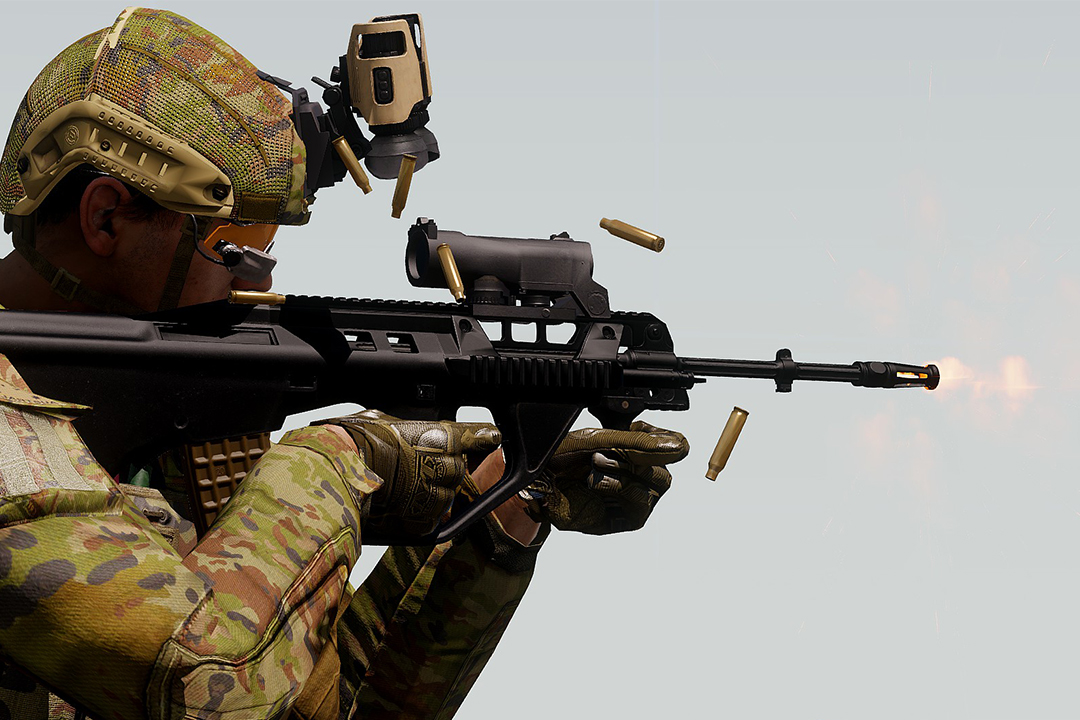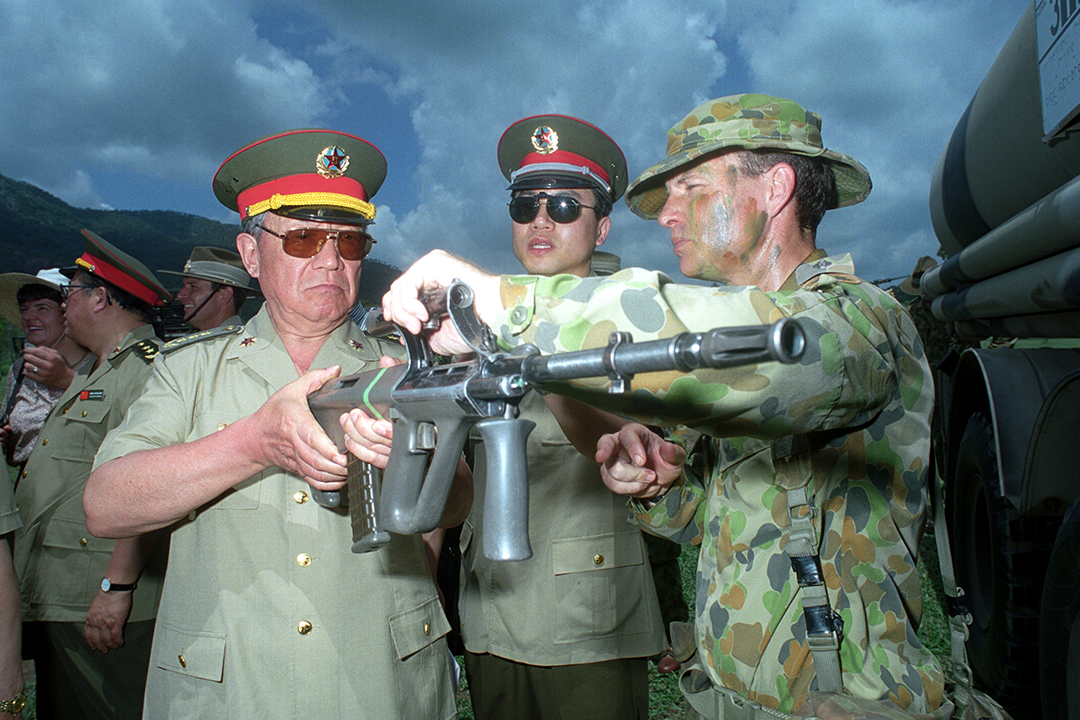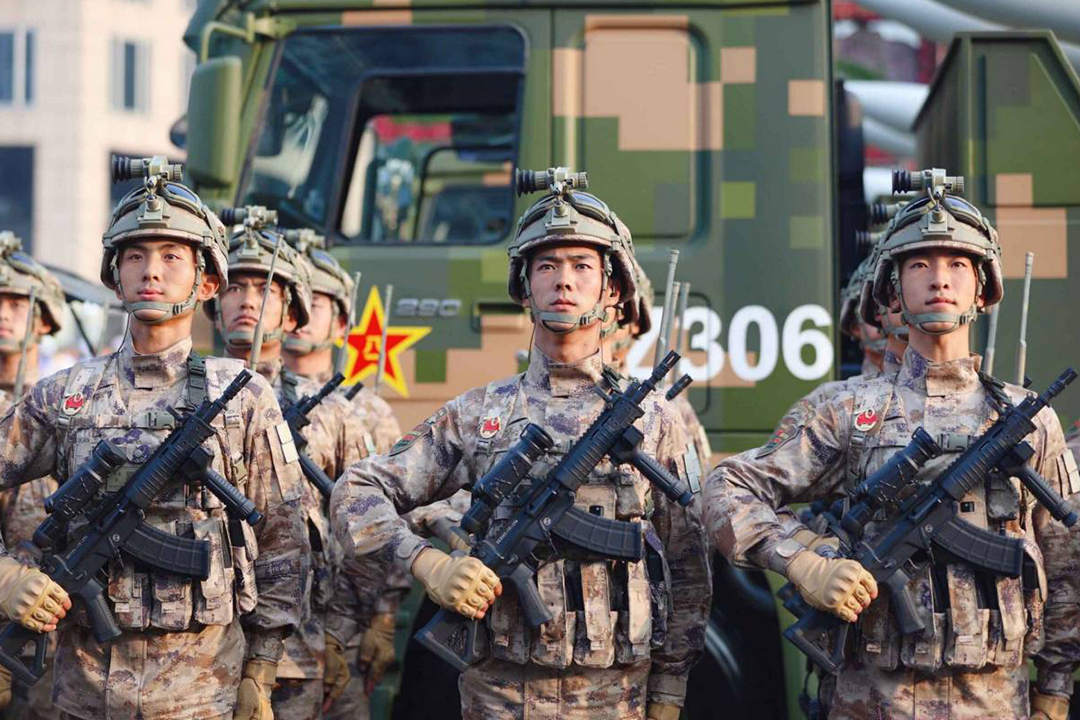
Western manufacturers are now seeing increasingly successful small arms designs emerging from Asia.
The weapon carried by every soldier not only impacts on their effectiveness in combat but also makes a statement becoming a part of the overall identity of a country’s military. The selection of that weapon can also be a matter of national pride with the development, production and fielding of an indigenous design to equip one’s military. There is also a constant push to stay current with the latest technology and weapon design trends. In addition, the level of modernisation of a country’s individual weapons can be viewed as a reflection of the efficiency and indication of the combat capabilities of its military. As a result, a significant attention can given to the arming of the soldier, as well as to the procurement or local development of state-of-the-art modern weapons. This trend has been equally true by nations in the Asian-Pacific region with a number of these designing and fielding their own world class weapons. The region is today not only a market for advanced weapons but an exporter of individual arms in their own right.
Given the national prestige associated with having local small arms and the specific requirements of military it is not surprising that some facilities are government supported and even government owned or affiliated. Yet, many of their designs have come to reflect state-of-the art designs utilising current material technologies. Their configurations reflect and draw upon the latest trends and design approaches including the bullpup, AR, AK, SCAR, as well as combinations of various proven features. Rather than replicating other weapon designs these are often incorporated into their own well- thought-out innovative features. The ability of these facilities to manufacture and offer their weapons at highly competitive prices has positioned them as an attractive weapon source for many world armies.
Singapore
The Singapore Armed Forces (SAF) enjoy the continued support of ST Engineering in addressing many of its needs. This has been particularly the case with its small arms. The company began with license production of the M16, referred to as the M16S1, as well as the SAR80 which was licensed for export. However, around 1995 the company began its own development. The resulting SAR-21 (Singapore Assault Rifle – 21st Century) was fielded by its army in 1999 and remains in service. The SAR-21 is a bullpup design utilising 5.56×45 caliber with a Stoner operating system, a high impact polymer body, and translucent magazine. It is compact at 805mm (31.7 inch) length in the assault rifle version and 640mm (25.2in) in the carbine facilitating its handling in tight situations such as urban areas, jungles and inside vehicles. The original design incorporated an integral 1.5 power optical sight (or 3x) and battery powered laser aiming device, but it has subsequently been provided with a Picatinny mounting rail. A lighter 3.2 kilogram (7lb) SAR-21A model was introduced in 2006. In addition to the SAF, the SAR21 has been adopted by seven militaries especially special forces units.
In 2018 ST Engineering debuted the production design of its BMCR (Bull-pup Multirole Combat Rifle) subsequently designated the BR18, developed to replace the SAR21. A company spokesperson shared, “BM18 builds off the SAR21incorporating lessons learned and user inputs on the earlier weapon.” The receiver incorporates both an upper and lower Picatinny Rail, with the later able to mount a forward grip while the transparent magazine is retained. Overall, the weapon is an even more compact package with the assault model having a length of only 640mm (25in) and 2.9kg (6lb) weight. These characteristics make the BR18 a suitable choice for infantry, mechanised troops, paratroopers, or Special Forces without need for significant modifications.
Indonesia
PT Pindad (Perindustrian Tentara Nasional Indonesia-Angkatan Darat (Indonesian Army Industries) has been manufacturing weapons since 1808 and began the licensed production of the FN FNC rifle which was adopted by the Indonesian military in 1994 as the SS1. A number of variants of the 5.56mm rifle have been designed and fielded including the SS1-V5 with a 252mm barrel, 3.37kg (7.4lb) weight and foldable butt for use by artillery, rear-echelon troops and special forces. The M Versions are used by the Indonesian Marine Corps with a special coating process to protect against salt water corrosion. In 2005 the company introduced its SS2 which improves on the SS1 design. It includes a folding stock and Picatinny Rail and like the SS1 is offered in a number of variants.
Australia
The Australian Army adopted the Steyr Mannlicher bullpup style F88 Austeyr assault rifle manufactured under license by Thales Australia. Their rifles, as well as those of the New Zealand Army which also use the F88, have a 1:7 twist rifling optimised for firing the NATO 5.56mm SS109 round. The last variant, the F88SA2, can be fitted with different sights including the standard 1.5x ring-sight, the Advanced Combat Optic Gunsight (ACOG) or night weapon sights, as well as laser aiming devices and other accessories that attach to a Picatinny rail. The assault rifle version weights 4.8kg (10.5lb) with a full 30 round magazine and has an overall length of 790mm (31.6in) but is also available in a shorter close-quarters battle (CQB) carbine, longer barrel marksman, and heavy barrel automatic weapon versions.
In 2015 the Ministry of Defence awarded a contract to Thales for the Enhanced F88 (EF88) also offered for export as the F90. EF88 incorporates a number of improvements including a folding cocking handle, modified hammer to improve reliability, extended ejection port and improved port covers, upgraded gas plug adjustment, bolt release catch and a modified trigger guard grip access. Of immediate notice is the elimination of the integrated optic sight from the original F88. Instead, extended Picatinny rails allowing for the use of various optics, laser aimers, and the mounting of a grenade launcher. The EF88 is being fielded by the Australian Army in both the standard assault rifle and CQB versions. The F88 is used by 30 militaries including Malaysia, Papua New Guinea, and elements in the Philippines.


Japan
Japan has been manufacturing its own individual weapons since the formation of the Japanese Self Defense Forces. Following the U.S. move from 7.62mm to 5.56mm the Defense Agency followed suit and selected Howa, which had the license for the Armlite AR-18, to design a new rifle to replace the Type 64. This was the Type 89 assault rifle which uses standard magazines and has a selector for semi-auto, three-shot burst, and full automatic firing. In 2015 the Defense Agency began evaluating rifles to replace the Type 89 and in August 2020 announced its selection of the Howa Type 20. It is 780mm (30.7in) long and weighs 3.5kg (7.7lbs). It is ambidextrous with controls on both sides of the rifle and the charging handle can be swapped. The weapon has a full-length Picatinny top rail and an MLOK fore-end, with MLOCK slots. Special coatings have been applied to counter salt and corrosion. The Type 20 has been viewed with a DECON 1×8 power variable scope optic and has metal back-up iron sights. There is a forward grip and a an adjustable telescoping stock. The rifle can mount the Beretta GLX-160 grenade launcher. It is understood that the Type 20 will be issued first to those in the Amphibious Rapid Deployment Brigade on the Nansei Islands.

Republic of Korea
Taking a path similar to other countries in the region the Republic of Korea chose to develop and manufacture its own combat rifle drawing from a proven operating system, in this case that of the Stoner AR-18. The resulting K2 is manufactured by S&T Motiv (formerly Daewoo) and was introduced in 1984. Its gas operation was slightly modified based on the AKM to increase reliability while the weapon also employs a stamped and welded sheet steel construction thereby simplifying manufacturing. The weapons 970mm (38.8in) length is reduced to 780 mm (31.5 in) with its folding. It is designed for selective fire and is chambered for NATO 5.56x45mm ammunition using the standard 30 round magazine. Over the years the K2 has been updated and improved with the K2A having a different foregrip and a full-length Picatinny rail that accepts various optics and accessories without blocking its iron sights. There is also a shorten carbine version, the K2C. The K2 has been accepted by Bangladesh, Fiji, Indonesia, Lebanon, Nigeria, Peru and Senegal.
Early in 2020 S&T Motiv and Poongsan, the largest ammunition producer, announced that they are together developing a new generation assault rifle using a new 6.8mm ammunition. According to Hong Hui-beom, of the Korean magazine Platoon, the objective is to achieve increased accuracy, longer 500m plus range and better penetration than the current 5.56mm. S&T have suggested their intent is to have a prototype within 24 months although the Korean Army has yet to layout its plans for a new rifle.
Democratic People’s Republic of Korea
In line with many other countries that were within the sphere of the former Soviet Union, North Korea adopted the AK-47, the AKM and finally the AK-74 which they began to manufacture. These models were given a local Type designation with the later renamed the Type 88. They further introduced their own modifications to the weapons. The helical ammunition magazines were first seen in 2010. Much larger the standard 30-round ‘banana’ magazines, it is estimated that these hold between 100 and 150 rounds. Their use increases the loaded weapon weight from 3kg (6.6lb) to around 5kg (11lb), a significant load to carry. However, this large capacity magazine might well have a particular application by allowing sustained fires without having to change magazines. Thus, a single soldier using the AK-74 with a helical magazine could by himself provide suppressive fires in support of a unit’s manouvere. Given the scale of North Korea’s previous rifle production – as high as 150,000 annually – the country is a major player in the small arms.
Taiwan
The Combined Logistics Command of the Republic of China Armed Forces has developed individual weapons since 1976. The first in the 5.56 caliber was the T65 patterned after the Armalite AR-18. However, the design sought to improve the AR by utilising a short stroke gas piston thereby improving the rifle’s reliability. T65 resembles the U.S. M16 with a sight block instead of a carrying handle although the carrying handle returned in the T65K2 improved model. A carbine version like the M4 is also fielded. The T65 has proved popular in Central America and is fielded in seven countries.
In 1998 the development of the T86 Combat Rifle was completed as a replacement for the T65. The T86 further improves on the T65K2 and features an M4 carbine style polymer telescopic stock and buffer mechanism and polymer handguard. However, the T86 has seen only limited fielding and has been largely superseded by the T91 which entered production in 2002. The T91 is even shorter at 800mm (32in) with the stock collapsed. It also incorporates multiple Picatinny rails with the standard carrying handle able to be removed allowing optics to be mounted.
In 2009 the Ministry of National Defense displayed its XT97 5.56 assault rifle as advanced a new multipurpose rifle development. It departed from previous designs by utilising the AK bolt. The weapon also features a stock that is both retractable and foldable. This allows the weapon length to change from 850mm (34in) stock extended, to 770mm (30.8in) stock retracted, to only 580mm (23.2in) stock folded. This characteristic clearly enhances the utility of the weapon for use in a range of soldier applications. The rifle also incorporates Picatinny rails for mounting various optical scopes. In 2015, a version was added that could be provided with three different barrel lengths.
Peoples Republic of China
In 1995 Norinco began series production of its Type 95 (also referred to as QBZ-95), an entirely new local bullpup design that would replace the Type56, an AK-47 copy, that had previously been used. Chambered for the 5.8×42mm DBP87 intermediate cartridge it is designed as a family of weapons including the assault rifle, a carbine, and a light support weapon (LSW) or Squad Automatic Rifle (SAR). The rifle weight is 3.25kg (7.2 lb) with overall length of 745mm (29.3in). Its integrated carrying handle has mounting fixtures to accept a Y/MA95-002 telescopic sight. With selective fire, including full automatic, the weapon was designed around and to optimise the accuracy and performance of the 5.8x42mm caliber. The PRC claims its choice is superior to both the NATO 5.56x345mm and the Russian 5.45x39mm with a flatter trajectory that retains its energy to greater ranges. However, the military has introduced a new heavier DBP10 round in the same caliber that further enhances performance and increasing the effective range. This new ammunition necessitated modifications to the QBZ-95 which is designated the QBZ-95-1 as a heavier, longer barrel and a redesigned muzzle brake. The rifle is widely issued including to security forces and militia.
As early as 2017 reports surfaced of a newly developed assault rifle reflecting a return to previous magazine forward configuration. In late 2019 this rifle appeared with troops in the 70th anniversary parade. It appears to be 5.8x42mm using the DBP10 round. It is designated the QBZ-191 (Qingwuqi Buqiang Zidong – light weapon, rifle automatic). The layout includes a top full Picatinny-type rail that has been seen mounting the QMK-152 3X light-gathering fibre optic sight. It further incorporates a four-position adjustable buttstock, removable forward grip and can add a bipod. The 30-round curved magazine appears to be modified for secure hold and easier installation. Several barrel lengths have been seen including a 267mm (10.5in) carbine and 368mm (14in) infantry rifle, while an even longer heavier barrel QBU-191 with a digital variable scope ‘precision marksman’ version was revealed in May 2020. The QBZ is part of a broader PLA program toward introducing an Integrated Soldier System.

United States
The very size of the US military’s small arms requirements assures that its fielding decisions can have worldwide impact. Its adoption of the 5.56 caliber influenced the move by NATO and other militaries. Currently, the U.S. Army is in the process of evaluating three candidates for its Next Generation Squad Weapon. A new 6.8 caliber projectile is directed; however, competitors can match this with any ammunition approach. Three competitors are being considered: Sig Sauer, General Dynamics – Ordnance and Tactical Systems, who use polymer case but conventional round configuration, while Textron Systems employs its cased telescope round design. The later round design allows for an entirely new receiver and forward ejection approach. With a 2023 initial fielding objective the influence of this caliber shift and the introduction of new ammunition designs as well as weapons will be a development to watch.
New World Class Small Arms
The Asian-Pacific small arms industry which had established its credentials as a manufacturer some years ago is now displaying its expertise as a world class designer and developer as well. The implications of this, particularly with the increasing incorporation of electronics and processing into weapons, technologies in which these countries lead, may well set the stage in arming future soldiers.
by Stephen W. Miller












